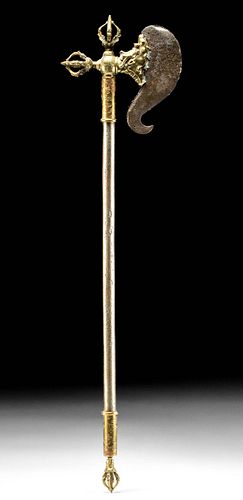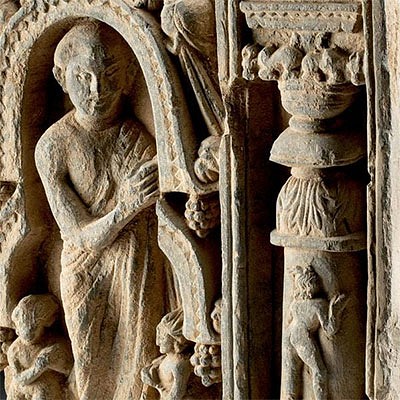19th C. Tibetan Buddhist Brass & Iron Kartika Axe
Lot 137
About Seller
Artemis Gallery
686 S Taylor Ave, Ste 106
Louisville, CO 80027
United States
Selling antiquities, ancient and ethnographic art online since 1993, Artemis Gallery specializes in Classical Antiquities (Egyptian, Greek, Roman, Near Eastern), Asian, Pre-Columbian, African / Tribal / Oceanographic art. Our extensive inventory includes pottery, stone, metal, wood, glass and textil...Read more
Categories
Estimate:
$900 - $1,400
Absentee vs Live bid
Two ways to bid:
- Leave a max absentee bid and the platform will bid on your behalf up to your maximum bid during the live auction.
- Bid live during the auction and your bids will be submitted real-time to the auctioneer.
Bid Increments
| Price | Bid Increment |
|---|---|
| $0 | $25 |
| $300 | $50 |
| $1,000 | $100 |
| $2,000 | $250 |
| $5,000 | $500 |
| $10,000 | $1,000 |
| $20,000 | $2,500 |
| $50,000 | $5,000 |
| $100,000 | $10,000 |
| $200,000 | $20,000 |
About Auction
By Artemis Gallery
Sep 16, 2021
Set Reminder
2021-09-16 10:00:00
2021-09-16 10:00:00
America/New_York
Bidsquare
Bidsquare : Ancient & Ethnographic Art Through The Ages
https://www.bidsquare.com/auctions/artemis-gallery/ancient-ethnographic-art-through-the-ages-7473
Ancient art from Egypt, Greece, Italy and the Near East, as well as Asian, Fossils, Pre-Columbian, Native American, African / Tribal / Oceanic, Fine art, and much more! All categories, all price ranges... all legally acquired and guaranteed to be as described or your money back. Artemis Gallery info@artemisgallery.com
Ancient art from Egypt, Greece, Italy and the Near East, as well as Asian, Fossils, Pre-Columbian, Native American, African / Tribal / Oceanic, Fine art, and much more! All categories, all price ranges... all legally acquired and guaranteed to be as described or your money back. Artemis Gallery info@artemisgallery.com
- Lot Description
Central Asia, Tibet, ca. 19th century CE. A ceremonial iron axe with a curved iron blade attached to a mythical brass makara head and dorjes. The socketed blade attaches to an iron handle that terminates with a brass socket and dorje pommel. The curved blade emerges from the makara's open mouth, like an enormous tongue. The pommel and axe socket are engraved with auspicious symbols of scrolling clouds, bats, lotus, and each rib of the dorje is formed by additional makara heads. The pommel dorje rests upon a Buddha head, forming a crown. The dorje, an instantly recognizable symbol of Tibetan Buddhism, represents the moment of Enlightenment. This type of knife is known as a Kartika, and it is designed to be used for ritual flaying in Tantric ceremonies. This blade is mounted on a lengthy handle, perhaps to use in a procession. The form is derived from the traditional Indian butcher's knife; however, the blade is not sharpened and only represents ritualistic cutting. Size: 31.25" L x 8" W (79.4 cm x 20.3 cm)
This axe has many significant auspicious and symbolic Buddhist iconography. The Makara ("sea dragon" or "water monster" in Sanskrit) is the pet and Vahana (vehicle) of the river goddess Ganga of Hindu mythology, who personifies the purity and piety of the Ganges River (the most sacred river of Hindu mythology) and purportedly descends to earth to rinse away humankind's sins. A row of Makara is typically featured on the exteriors of Hindu temples, running along a wall or serving as a handrail. As a vahana ("that which pulls"), the Makara is sometimes depicted mounted by a deity, at the deity's side, or as a symbolic attribute of the deity, in this case it would be Ganga. Makara are often depicted with the frontal part as an elephant or other terrestrial animal Here he is portrayed with bulging eyes, two antlers, curling mane, and rows of sharp teeth.
Provenance: private Englewood, Colorado USA collection; ex-M. Komor Gallery, New York City, New York USA circa 1965
All items legal to buy/sell under U.S. Statute covering cultural patrimony Code 2600, CHAPTER 14, and are guaranteed to be as described or your money back.
A Certificate of Authenticity will accompany all winning bids.
PLEASE NOTE: Due to recent increases of shipments being seized by Australian & German customs (even for items with pre-UNESCO provenance), we will no longer ship most antiquities and ancient Chinese art to Australia & Germany. For categories of items that are acceptable to ship to Australia or Germany, please contact us directly or work with your local customs brokerage firm.
Display stands not described as included/custom in the item description are for photography purposes only and will not be included with the item upon shipping.
#167232Repaired with visible adhesive residue along blade to dragon mouth. Blade panels are also splitting down the cutting edge "seam." Pommel finial is bent. Surface pitting and nicks to surfaces throughout. Great areas of patina and signs of age.Condition
- Shipping Info
-
All shipping is handled in-house for your convenience. Your invoice from Artemis Gallery will include shipping calculation instructions. If in doubt, please inquire BEFORE bidding for estimated shipping costs for individual items.
-
- Buyer's Premium



 EUR
EUR CAD
CAD AUD
AUD GBP
GBP MXN
MXN HKD
HKD CNY
CNY MYR
MYR SEK
SEK SGD
SGD CHF
CHF THB
THB














